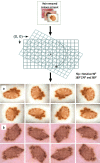DDCNN-F: double decker convolutional neural network 'F' feature fusion as a medical image classification framework
- PMID: 38182607
- PMCID: PMC10770172
- DOI: 10.1038/s41598-023-49721-x
DDCNN-F: double decker convolutional neural network 'F' feature fusion as a medical image classification framework
Abstract
Melanoma is a severe skin cancer that involves abnormal cell development. This study aims to provide a new feature fusion framework for melanoma classification that includes a novel 'F' Flag feature for early detection. This novel 'F' indicator efficiently distinguishes benign skin lesions from malignant ones known as melanoma. The article proposes an architecture that is built in a Double Decker Convolutional Neural Network called DDCNN future fusion. The network's deck one, known as a Convolutional Neural Network (CNN), finds difficult-to-classify hairy images using a confidence factor termed the intra-class variance score. These hirsute image samples are combined to form a Baseline Separated Channel (BSC). By eliminating hair and using data augmentation techniques, the BSC is ready for analysis. The network's second deck trains the pre-processed BSC and generates bottleneck features. The bottleneck features are merged with features generated from the ABCDE clinical bio indicators to promote classification accuracy. Different types of classifiers are fed to the resulting hybrid fused features with the novel 'F' Flag feature. The proposed system was trained using the ISIC 2019 and ISIC 2020 datasets to assess its performance. The empirical findings expose that the DDCNN feature fusion strategy for exposing malignant melanoma achieved a specificity of 98.4%, accuracy of 93.75%, precision of 98.56%, and Area Under Curve (AUC) value of 0.98. This study proposes a novel approach that can accurately identify and diagnose fatal skin cancer and outperform other state-of-the-art techniques, which is attributed to the DDCNN 'F' Feature fusion framework. Also, this research ascertained improvements in several classifiers when utilising the 'F' indicator, resulting in the highest specificity of + 7.34%.
© 2024. The Author(s).
Conflict of interest statement
The authors declare no competing interests.
Figures

















Similar articles
-
2-HDCNN: A two-tier hybrid dual convolution neural network feature fusion approach for diagnosing malignant melanoma.Comput Biol Med. 2023 Jan;152:106333. doi: 10.1016/j.compbiomed.2022.106333. Epub 2022 Nov 19. Comput Biol Med. 2023. PMID: 36463793
-
Developing a Recognition System for Diagnosing Melanoma Skin Lesions Using Artificial Intelligence Algorithms.Comput Math Methods Med. 2021 May 15;2021:9998379. doi: 10.1155/2021/9998379. eCollection 2021. Comput Math Methods Med. 2021. PMID: 34055044 Free PMC article.
-
Fusing fine-tuned deep features for skin lesion classification.Comput Med Imaging Graph. 2019 Jan;71:19-29. doi: 10.1016/j.compmedimag.2018.10.007. Epub 2018 Nov 3. Comput Med Imaging Graph. 2019. PMID: 30458354
-
Review of medical image recognition technologies to detect melanomas using neural networks.BMC Bioinformatics. 2020 Sep 14;21(Suppl 11):270. doi: 10.1186/s12859-020-03615-1. BMC Bioinformatics. 2020. PMID: 32921304 Free PMC article. Review.
-
Deep Learning Approaches Towards Skin Lesion Segmentation and Classification from Dermoscopic Images - A Review.Curr Med Imaging. 2020;16(5):513-533. doi: 10.2174/1573405615666190129120449. Curr Med Imaging. 2020. PMID: 32484086 Review.
Cited by
-
Skin Lesion Classification Through Test Time Augmentation and Explainable Artificial Intelligence.J Imaging. 2025 Jan 9;11(1):15. doi: 10.3390/jimaging11010015. J Imaging. 2025. PMID: 39852328 Free PMC article.
-
Artificial Intelligence in Dermoscopy: Enhancing Diagnosis to Distinguish Benign and Malignant Skin Lesions.Cureus. 2024 Feb 21;16(2):e54656. doi: 10.7759/cureus.54656. eCollection 2024 Feb. Cureus. 2024. PMID: 38523958 Free PMC article.
-
Kidney cancer diagnosis and surgery selection by double decker convolutional neural network from CT scans combined with great wall construction algorithm.Abdom Radiol (NY). 2025 Apr 5. doi: 10.1007/s00261-025-04900-4. Online ahead of print. Abdom Radiol (NY). 2025. PMID: 40186648
References
-
- Singh, S. K., Banerjee, S., Chakraborty, A., & Bandyopadhyay, A. (2023). Classification of Melanoma Skin Cancer Using Inception-ResNet. In Frontiers of ICT in Healthcare: Proceedings of EAIT 2022 (pp. 65–74). Singapore: Springer Nature Singapore.
-
- Poornimaa JJ, Anithaa J, Henrya AP, Hemantha DJ. Melanoma classification using machine learning techniques. Design Stud. Intell. Eng. Proc. DSIE. 2023;2022(365):178.
MeSH terms
LinkOut - more resources
Full Text Sources
Medical

